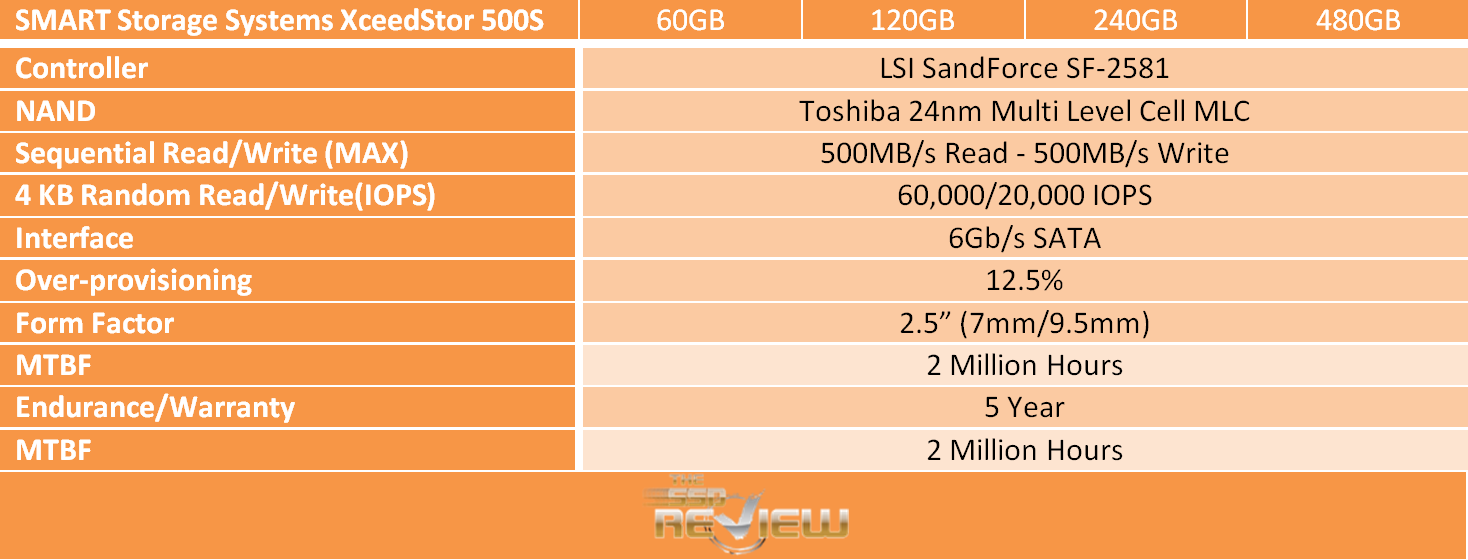Our SSD analysis today will be on the SMART Storage Systems XCeedStor 500S 240GB MLC enterprise SSD and SMART hopes to cater to the exploding Light-Enterprise market with this new enterprise entry.
Many users are now substituting client SSDs for more price-conscious approaches to boosting read-centric environment performance which can expose users to data integrity and security concerns, making the XCeedStor 500S a much needed entrant to this space.
PRODUCT SPECIFICATIONS
At the entry-level, there has been a mass adoption of client SSDs to fill an obvious gap in product segmentation between the write-intensive high end and the read-oriented light enterprise. The market for the lower end is understandably very enticing for manufacturers, and we have seen a few key players embrace this segment. With the entry level market obviously being exponentially larger than the high performance and mainstream segments, there is a big piece of pie up for grabs.
Client SSDs do lack several of the key technologies that make enterprise SSDs a necessity for ensuring data protection and reliability. Key amongst these is the class of controllers that are utilized.
The XceedStor 500S leverages the LSI SandForce SF-2581 controller with Tier-One OEM-enterprise firmware that is designed for data integrity. This platform allows for several vital improvements to data integrity, starting with an impressive Uncorrectable Bit Error Rate (UBER) of less than 1 in 10(18) bits read. This level of protection really stands out simply because it is a 100X improvement over the JEDEC JESD 218 specification for enterprise grade SSDs. Considering that this performance is above and beyond the standards for even the highest level of SSDs, consumer SSDs certainly pale in comparison.
 The performance is geared towards read heavy environments, with 500MB/s both read and write for sequential access, and 60,000/20,000 read/write IOPS. These levels of performance are delivered over a 6Gb/s SATA connection, which ensures wide compatibility and a lower price structure than SAS.
The performance is geared towards read heavy environments, with 500MB/s both read and write for sequential access, and 60,000/20,000 read/write IOPS. These levels of performance are delivered over a 6Gb/s SATA connection, which ensures wide compatibility and a lower price structure than SAS.
Pairing this type of performance with Toshiba 24nm MLC NAND is perhaps one of the most compelling attributes of this SSD. MLC keeps the price low, which is a necessity for the intended customer base. The key is to also deliver the upper-end goods at the lower price points.
The LSI SF-2581 also brings heightened ECC, data path protection, thermal monitoring, and data fail recovery up to 1 NAND flash erase block of data. AES 256 Encryption supports users with an high level of data security, and adding in power protection with discrete capacitors provides an extra level of protection. With a MTBF of 2 million hours and a 5 Year warranty there is also a promise that the hardware itself is very reliable.
INTERNAL CHARACTERISTICS
The SMART XceedStor 500S comes with a very light aluminum case in a 2.5in form factor. The SSD can be purchased with either a 7mm or a 9.5mm z-height, which provides a slim profile for a multitude of applications.


The case of the SSD is very simple, and the 240GB engineering sample that we received was devoid of the typical branded sticker on the top of the SSD. The bottom of the case reveals four Phillips head screws which allow easy access to the internal components. Once dissembled the 8x32GB modules of Toshiba 24nm MLC NAND (TH58TEG8D2HBA8C) come into view.
After the 12.5% overprovisioning (OP) is taken into account we come out with 224GB of space that is user addressable. Most enterprise SSDs come with 28% overprovisioning. In this case, SMART has chosen to provide a higher capacity for a better cost to GB ratio. OP helps to increase endurance and write performance, but with the option of manually providing extra OP space the user can leverage some benefits of higher OP levels if it suits their workload.
The engine behind the NAND management is the LSI SF-2581 processor, visible near the SATA connector on the top of the PCB. LSI SandForce processors provide both high performance and extremely low write amplification. The compression technology that is inherent to SandForce processors helps to extend the longevity of the MLC that is utilized for this SSD.


Finally we come to the discrete capacitors which are lined along the edge of the PCB below. These allow the SSD to flush all data to NAND in case of a power outage. This is one aspect that this type of SSD can deliver that client side SSDs simply cannot. The selection of discrete capacitors over super-capacitors enables this SSD to function at much higher thermal envelopes. The capability to function at temperatures over 70C is very important in 1U and 2U server racks, as these slim form factors have limited airflow which usually result in higher operating temperatures. Paired with the option of a 7mm z-height, these SSDs are very well suited for slim applications.
 The SSD Review The Worlds Dedicated SSD Education and Review Resource |
The SSD Review The Worlds Dedicated SSD Education and Review Resource | 